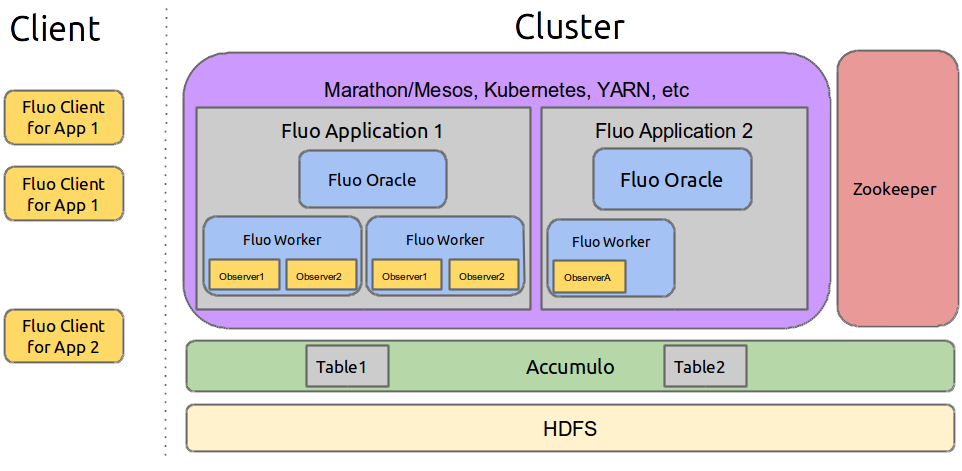Fluo 1.2.0 documentation >> Getting started >> Design
Design
The diagram below provides an overview of Apache Fluo’s design.

Background
The design of Apache Fluo is inspired by Google’s Percolator which is described as being used to populate Google’s search index.
Fluo Application
A Fluo application maintains a large scale computation using a series of small transactional updates. Fluo applications store their data in a Fluo table which has a similar structure (row, column, value) to an Accumulo table except that a Fluo table has no timestamps. A Fluo table is implemented using an Accumulo table. While you could scan the Accumulo table used to implement a Fluo table using an Accumulo client, you would read extra implementation-related data in addition to your data. Therefore, developers should only interact with the data in a Fluo table by writing Fluo client or observer code:
- Clients ingest data or interact with Fluo from external applications (REST services, crawlers, etc). These are generally user started process that use the Fluo API.
- Observers are user provided functions run by Fluo Workers that execute transactions in response to notifications. Notifications are set by Fluo transactions, executing in a client or observer, when a requested column is modified.
Multiple Fluo applications can run on a cluster at the same time. Fluo applications consist of an oracle process and a configurable number of worker processes:
- The Oracle process allocates timestamps for transactions. While only one Oracle is required, Fluo can be configured to run extra Oracles that can take over if the primary Oracle fails.
- Worker processes run user code (called observers) that perform transactions. All workers run the same observers. The number of worker instances are configured to handle the processing workload.
Fluo Dependencies
Fluo requires the following software to be running on the cluster:
- Accumulo - Fluo stores its data in Accumulo and uses Accumulo’s conditional mutations for transactions.
- Hadoop - Each Fluo application run its oracle and worker processes as Hadoop YARN applications. HDFS is also required for Accumulo.
- Zookeeper - Fluo stores its metadata and state information in Zookeeper. Zookeeper is also required for Accumulo.